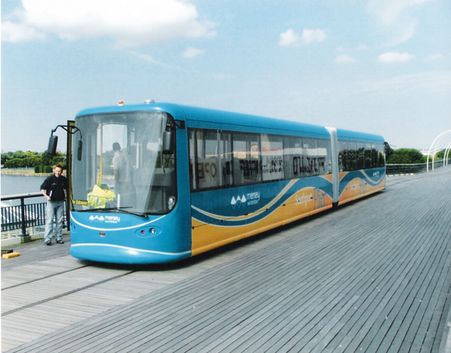Welcome to DU!
The truly grassroots left-of-center political community where regular people, not algorithms, drive the discussions and set the standards.
Join the community:
Create a free account
Support DU (and get rid of ads!):
Become a Star Member
Latest Breaking News
General Discussion
The DU Lounge
All Forums
Issue Forums
Culture Forums
Alliance Forums
Region Forums
Support Forums
Help & Search
Ultra Light Rail Claims Lower Risk and Lower Cost than Traditional Light Rail

Ultra Light Rail Claims Lower Risk and Lower Cost than Traditional Light Rail
ULRT uses electric buses on rails, with a few tweaks, that give it the potential to disrupt the way transit is built.
Steve Ostrowski
The greatest advancements in technology happen when great inventions collide. The wheel gets paired with an axle. The computer with a cell phone. And now, in the case of public transit, quick charge electric buses, with on-off-rail technology. It's called Ultra Light Rail Transit (ULRT) and it's being presented as a lower risk, lower cost alternative to light-rail transit (LRTs). Simply put, ULRT uses electric buses on rails, with a few tweaks, that give it the potential to disrupt the way transit is built.
But how can this be? New technology can be wrought with risk,, expensive, packed with more computers, more autonomy, more software and more cost. So, it seems unreasonable that new technology can be lower risk.
But ULRT claims are extraordinary: fast construction, low cost, BRT reliability, LRT performance and the smallest carbon footprint. The upside of these claims could change how people move in the 21st Century, so it is time to revisit how public transit assesses risk.
The simplest definition of risk is 'the possibility of loss' and by that definition, one can make a compelling case for ULRT to be lower risk than LRT. ULRT proponents reason the degree of risk, reduced by lower cost and shorter construction time, exceeds the degree of risk assumed by it being a new approach to transit design and construction. ................(more)
https://www.masstransitmag.com/rail/infrastructure/article/21213369/ultra-light-rail-claims-lower-risk-and-lower-cost-than-traditional-light-rail
InfoView thread info, including edit history
TrashPut this thread in your Trash Can (My DU » Trash Can)
BookmarkAdd this thread to your Bookmarks (My DU » Bookmarks)
3 replies, 1443 views
ShareGet links to this post and/or share on social media
AlertAlert this post for a rule violation
PowersThere are no powers you can use on this post
EditCannot edit other people's posts
ReplyReply to this post
EditCannot edit other people's posts
Rec (2)
ReplyReply to this post
3 replies
 = new reply since forum marked as read
Highlight:
NoneDon't highlight anything
5 newestHighlight 5 most recent replies
= new reply since forum marked as read
Highlight:
NoneDon't highlight anything
5 newestHighlight 5 most recent replies
Ultra Light Rail Claims Lower Risk and Lower Cost than Traditional Light Rail (Original Post)
marmar
Mar 2021
OP
Thunderbeast
(3,406 posts)1. Why rails at all?
The article does not address the advantage of driving electric busses on rails. I know that the investments in rail systems for LRT and streetcars have stimulated urban density, but how does ULRT differ fro articulated electric busses?
An electrified BRT vehicle driving from station to station with priority signalling and selective dedicated lanes should serve the same numbers.
Any transit geeks out there that can help me with this?
Dem_in_Nebr.
(301 posts)3. the big deal is the amount of friction between rail and tires.
Rail has less friction than rubber tires do hence rail is more efficient.
mahatmakanejeeves
(57,393 posts)2. Everything old is new again.
The Evans Auto Railer 1935
522 views•Mar 11, 2013
SuperBostyn
2.22K subscribers
Leuke clip uit het Prelinger archief (creative commons).Trein en bus in één maar nooit doorgebroken.Doet wel denken aan de Michéline die ook maar een kort leven kende in onze streken.